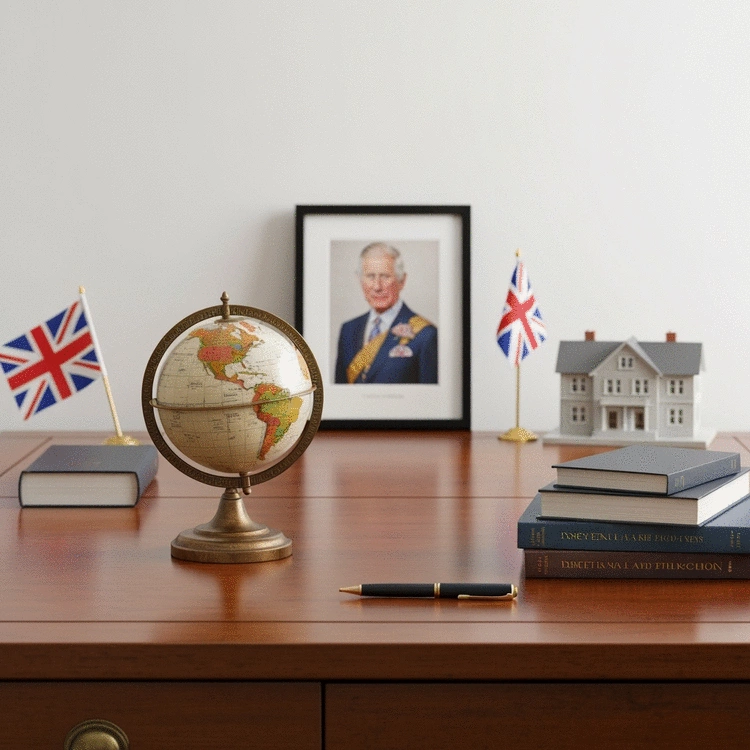As we dive into the multifaceted world of royal real estate, consider the implications of owning such historically significant properties. What stories do these estates tell, and how do they shape perceptions of the monarchy in today’s society?
What You Will Learn
- Diverse Holdings: King Charles III's portfolio includes iconic properties like Buckingham Palace, Windsor Castle, and Balmoral Castle, each rich in history.
- Cultural Impact: The royal residences serve as cultural landmarks, preserving British heritage and attracting tourism.
- Economic Contributions: Royal properties boost local economies through tourism and related activities, demonstrating their broader economic significance.
- Sustainability Practices: King Charles emphasizes environmentally friendly management of royal estates, promoting sustainability in property management.
King Charles III's Property Portfolio Overview
A visual summary of the key properties and their significance within King Charles III's extensive real estate holdings.
Overview of Holdings
- •Diverse Holdings: Royal residences, private estates, agricultural land.
- •Environmental Focus: Emphasizes sustainability across royal properties.
- •Cultural Heritage: Preserves British history and identity.
Key Royal Residences
- •Buckingham Palace: Official residence, working palace.
- •Windsor Castle: Historic fortress, royal ceremonies.
- •Balmoral Castle: Private Scottish retreat, family connection.
- •Sandringham House: Cherished private estate.
Market Implications
- •Market Trends: Inspire luxury developments, renovations.
- •Public Interest: Stimulate tourism, local economy.
- •Sustainability: Encourage eco-friendly efforts in private sector.
Understanding King Charles III's Real Estate Holdings
As we explore the intricate world of royal properties, it’s clear that King Charles III's real estate holdings are both vast and diverse. His portfolio includes a mix of historic royal residences and private estates, each with its own unique story and significance. By delving into these properties, we uncover not just their monetary value but also their cultural and historical relevance.
From regal castles to sprawling estates, King Charles III's properties reflect a rich tapestry of history and tradition. In this section, we will take a closer look at the key elements of his property portfolio, helping you understand the scope of royal real estate in the modern age.

Overview of King Charles III's Property Portfolio
King Charles III's property portfolio is impressive, featuring an array of properties that include:
- Buckingham Palace - The official residence of the monarch, serving as a working palace and cultural landmark.
- Windsor Castle - One of the oldest and largest inhabited castles in the world, rich in royal heritage.
- Balmoral Castle - A private residence in Scotland, symbolizing the Queen's connection to the Scottish Highlands.
- Sandringham House - A cherished private estate where the royal family often gathers.
Each of these properties not only serves as a residence but also as a significant part of British history and culture. The grandeur of these estates embodies the traditions of the monarchy and the enduring legacy of royal families. It's worth noting that the Crown Estate, which King Charles III holds in trust for the nation, is valued at approximately £16 billion, generating significant profits that contribute to the public purse, as reported by sources like TLIO. The Crown Estate's financial success often leads to a profit bump for King Charles, as highlighted by Fortune, underscoring its economic significance.
Historic Royal Residences: A Closer Look
Among King Charles III's holdings, several royal residences stand out for their historical significance:
- Buckingham Palace - More than just a home, this palace is a symbol of the British monarchy and hosts numerous state functions.
- Windsor Castle - A fortress with over a thousand years of history, it remains the venue for royal ceremonies and events.
- Balmoral Castle - Known for its stunning Scottish landscapes, it is a retreat for the royal family, reflecting their love for the outdoors.
These residences are not merely places to live; they are repositories of history, often attracting tourists and historians alike. Each site has its own unique charm that contributes to the story of the monarchy.
Land Ownership and Historic Property Significance
Understanding land ownership in the context of historic properties is crucial. King Charles III's estates represent a blend of cultural heritage and modern stewardship. The implications of owning such historic properties are significant:
- Cultural Preservation - These estates play a vital role in preserving British history and culture for future generations.
- Economic Impact - Royal properties contribute to local economies through tourism and related activities.
- Environmental Stewardship - The management of these lands often involves sustainable practices that protect the environment.
As we reflect on these points, it becomes evident that King Charles III's properties are not just about real estate but also about the responsibilities that come with such significant holdings. They embody a legacy that goes beyond bricks and mortar, influencing cultural narratives and community development throughout the UK. While the Crown Estate is significant, it's important to differentiate it from the King's personal wealth, which is also substantial, as detailed by The Independent's rich list insights.
Pro Tip
Did you know? The management of royal estates like those owned by King Charles III often focuses on sustainable practices. By integrating modern environmental stewardship with traditional property management, these estates can serve as models for private landowners looking to balance heritage with sustainability. Consider how similar approaches could benefit your own property management strategies!
Frequently Asked Questions About King Charles III's Real Estate
- What types of properties are included in King Charles III's portfolio?
- King Charles III's portfolio includes a diverse range of properties such as historic royal residences (e.g., Buckingham Palace, Windsor Castle), private estates (e.g., Balmoral Castle, Sandringham House), and extensive agricultural land. Many of these are held in trust for the nation as part of the Crown Estate.
- How do royal properties contribute to the British economy?
- Royal properties significantly contribute to the British economy through tourism, which generates revenue for local businesses and supports employment. The Crown Estate, in particular, generates substantial profits that are surrendered to the Treasury, benefiting the public sector.
- What is the significance of the Crown Estate?
- The Crown Estate is a vast portfolio of lands and holdings belonging to the monarch "in right of the Crown," meaning they are not the King's private property but are managed for the benefit of the nation. It is valued at billions of pounds and its profits are surrendered to the Treasury.
- Does King Charles III personally own all the royal properties?
- No, King Charles III does not personally own all royal properties. While he has private estates like Balmoral and Sandringham, many iconic properties like Buckingham Palace and Windsor Castle, along with the extensive holdings of the Crown Estate, are held by him in trust for the nation as the reigning monarch.
- How does King Charles III promote sustainability in his property management?
- King Charles III emphasizes environmentally friendly management across royal estates. This includes adopting sustainable practices in land management, conservation efforts, and encouraging eco-friendly renovations, setting an example for private landowners.
Summary of King Charles III's Real Estate Influence
King Charles III's real estate portfolio reflects a blend of tradition and modernity, showcasing the immense significance of royal property ownership in today's world. His holdings not only embody the historical legacy of the monarchy but also play a crucial role in contemporary discussions about sustainability and cultural heritage. The variety of properties, from royal residences to private estates, contributes to his broader influence on the real estate landscape.
As we recap the essentials of King Charles's real estate holdings, it’s clear that his approach to property management intertwines with his commitment to environmental issues. This commitment is not merely a reflection of personal values but also shapes public perception of the monarchy in a rapidly changing world. From Buckingham Palace to the Duchy estates, each property tells a story of resilience, tradition, and future-oriented stewardship.

- Diverse Holdings: Includes royal residences, private estates, and agricultural land.
- Environmental Focus: Emphasizes sustainability across royal properties.
- Cultural Heritage: Plays a vital role in preserving British history and identity.
Ultimately, King Charles's real estate influence is a powerful narrative that bridges the past with the future, setting a precedent for how monarchy can coexist with modern societal values.
Engaging with Royal Real Estate: What to Expect
As we delve into the realm of royal estates, I encourage you to consider the implications of property ownership held by figures like King Charles III. What does it mean for society today? Beyond the opulence and grandeur, royal properties hold cultural and historical significance that resonates with many. The way these estates are managed can shape perceptions and inspire action towards sustainability in property management.
Thinking about the future, we must reflect on how royal real estate can influence societal values and community development. King Charles’s estates can lead the way in sustainable practices that encourage similar actions among private and public landowners alike. As we navigate through these discussions, we invite you to share your thoughts and insights.
Real Estate Market Implications of Royal Holdings
The investments made by King Charles III have a profound ripple effect on the UK property market. Properties associated with royalty often set trends, impacting both property values and development initiatives. Here are a few ways his holdings influence the broader market:
- Market Trends: Royal properties often inspire luxury developments and upscale renovations in surrounding areas.
- Public Interest: High-profile royal investments can stimulate tourism, increasing local economic activity.
- Sustainability Practices: The emphasis on environmentally-friendly renovations can encourage similar efforts in the private sector.
By understanding these implications, we can better appreciate how royal holdings not only shape the physical landscape but also influence societal values around property management and sustainability.
Invitation for Reader Interaction
Now, I’d love to hear from you! What are your thoughts on the topic of royal estates and their role in today's society? How do you perceive the balance between tradition and modern sustainability in property management? Share your ideas in the comments below, and let’s foster an engaging discussion about the future of royal real estate.
Recap of Key Points
Here is a quick recap of the important points discussed in the article:
- Diverse Holdings: King Charles III's portfolio includes a variety of royal residences, private estates, and agricultural land, reflecting the rich history of the monarchy.
- Environmental Focus: There is a strong emphasis on sustainability and environmentally-friendly practices across his royal properties.
- Cultural Heritage: King Charles III's estates play a crucial role in preserving British history and cultural identity for future generations.
- Economic Impact: Royal properties contribute to local economies through tourism and related activities, demonstrating their significant economic influence.
- Market Trends: The royal holdings set trends in the real estate market, impacting property values and development initiatives in surrounding areas.






